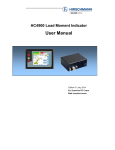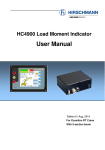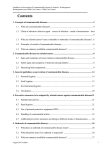Download EverFocus CCTV LCD Monitor User manual
Transcript
CCTV LCD MONITOR User manual Table of contents Important safety information------------------------------------------------------- 2~4 Contents----------------------------------------------------------------------------------- 5 Connection------------------------------------------------------------------------------- 5 Rear interface-------------------------------------------------------------------------- 5 Connection under various signal input mode---------------------------- 6 Connecting the Monitor Cables to your Computer------------------------------- 7 Testing the Monitor---------------------------------------------------------------------- 7 Controls & Functions-------------------------------------------------------------------- 8 Remote control -------------------------------------------------------------------------- 9 Basic on-screen display setup--------------------------------------------------------- 10 (1)VGA INPUT MODE--------------------------------------------------------------------- 11~13 (2)AV INPUT MODE-------------------------------------------------------------------- 14~15 (3)HDMI INPUT MODE-------------------------------------------------------------------16~17 SAFETY INFORMATION The power supply cord is used as the main disconnect device. Ensure that the outlet is located and installed near the monitor and is easily accessible. ENVIRONMENT ● Do not install the monitor outdoors or in any hostile environment. To prevent fire or electric shock, do not expose monitor to rain or moisture. Avoid placing the monitor in places subject to extreme temperature such as direct sunlight or near a heating appliance/equipment (such as amplifiers, etc) as this may result to overheating and damage. ● This monitor is designed to be used in the office or home. Do not subject it to vibrations, dust or corrosive gases. ● To obtain a clear picture, do not expose screen to direct illumination or sunlight. Using the monitor against a bright background and where sunlight or other light sources shines directly on the monitor can increase eye fatigue WIRING ● Unplug the main cord from the socket when wiring cables for safety. Take care not to catch your feet on the cables. POWER CORD ● Neither the monitor itself nor any other heavy object should rest on the power cord. ● Protect the power cord from being walked on or pinched particularly at plugs, convenience receptacles and the point where they exit from the monitor. ● Firmly grasp the plug when disconnecting the power cord. Do not pull the power cord itself. ● Do not modify or damage the cord. Damage to a power cord can cause fire or electric shock. ● Do not defeat the safety purpose of the grounding type plug. A grounding type plug has two blades and a third grounding prong. ● This monitor is designed to operate on 100-240V AC supply. Take caution in connecting too many appliances to the same socket as this could result in fire or electric shock. 2 3 MOUNTING ● Place the monitor on a secure table or have it properly mounted to the wall. Do not hang anything on the monitor. Caution: The wall mount must bear a minimum of five timesThe monitor’s net weight without causing damage.To mount your MONITOR to the wall 3 You need to remove the base first before attaching the wall mount. A. Place the MONITOR face down on a surface that is soft, yet strong enough to hold the MONITOR. B. Use a screwdriver to remove the screws from the four holes on each side of the bottom of the MONITOR’s base (only use with base) 2.Make sure all cables are already connected to the MONITOR. 3.Follow the directions included with the wall mount to mount the monitor to the wall. INACTIVE ● Unplug the monitor when unused for long periods of time. VENTILATION ● Never cover or block the ventilation slits in the monitor. Ventilation slits are provided to prevent the temperature from rising. A minimum distance of at least 10 cm should be maintained around the unit for sufficient ventilation. ● Never insert any foreign object, metal or liquid into the ventilation slits, as this could result in fire or electric shock. ● Do not install the DVR or optional equipments too close to the monitor. Keep these equipments at least 30 cm away from the monitor. WATER AND MOISTURE ● The monitor should not be exposed to dripping or splashing. No objects filled with liquids should be placed on the monitor. ● Do not use the monitor near water. ● Do not touch the monitor or cable with wet hands as this may cause electric shock or damage. CLEANING ● Unplug the unit from the wall outlet before cleaning. ● Do not use liquid or aerosol cleaners. Use a dry soft lint-free cloth for cleaning. If dust is persistent, wipe with a slightly damp cloth. SERVICE ● Use only the power source and connections appropriate for the monitor as indicated on the marking label. 4 ● Servicing is required when the monitor has been damaged in any way, such as power cord or plug is damaged, liquid has been spilled, objects have fallen into the apparatus, apparatus has been exposed to rain or moisture, does not operate manually, or has been dropped. 4 CONTENTS 1LCD Monitor, 1AC adapter, 1 VGA cable , 1 Audio cable , 1 User manual 1 Remote control (option) CONNECTION 1. Rear interface Explanation of connectors This section describes the jacks on the back panel of your MONITOR. There are several ways to connect devices. DC12V: Use only the power supply included with the monitor HDMI: High-Definition Multimedia Interface) This is an external interface for transmitting digital audio and video data. VGA Connect your computer, or other device with a VGA output, to this jack using a 15 pin D-sub cable. PC AUDIO IN (Stereo mini jack) Use to obtain sound when a PC is connected to the VGA jack. Use a 3.5 mm stereo mini pin cable (sometimes referred to as 1/8” stereo mini pin) to connect a PC to your MONITOR. VIDEO INPUT (AV1/AV2 IN) Lets you connect a device that has composite video jacks, such as a VCR or Camera VIDEO OUTPUT (AV OUT) Composite video loop though (to another monitor or recorder) AUDIO L and R: AV audio interface,The left audio connector is usually white. The right audio connector is usually red. 2. Connection under various signal input mode (Ⅰ)Connecting with PC,DVR at VGA 5 This connection allows you to connect to a PC or DVR. Connect one end of a 15-pin monitor cable to the VGA VIDEO jack on the monitor and the other end to the PC or DVR's video output jack. Note, if your PC's video output isn't 15-pin, you'll need an adapter that can connect to a 15-pin monitor cable. Connect your audio cable. Connect a 3.5 mm stereo mini pin cable (sometimes referred to as 1/8" stereo mini pin) to the PC AUDIO jack on the back of the monitor and the other end to the Audio Output jack on the PC or DVR. Viewing the PC or DVR 1. Plug in the MONITOR and the PC, if they aren't already plugged in. 2. Turn on the MONITOR and the PC. 3. Repeatedly press the SOURCE button to switch the display channel until you see VGA displayed at the top of the monitor's screen. To go back to viewing AV video, press the SOURCE button to enter AV mode (Ⅱ)Connecting the Device with Video This connection allows you to connect a device that has a Video Output, like, a camera, a DVR etc. Note: If the device you're connecting also has Component Video jacks and you have component video cables, we recommend you use the Component Video (Advanced) Connection instead. Connect your video cable (BNC). Connect a video cable to the BNC INPUT jack on the back of the monitor Connect your red and white audio cables. Connect the audio (red and white) cables to the AUDIO INPUT R and L jacks on the back of the monitor and to the Audio Output jacks on the DVR. Viewing the Picture from the Connected Device 1.Plug in the monitor and the device, if they aren't already plugged in. 2.Turn on the MONITOR and the device you want to view, for example a camera. 3.Repeatedly press the SOURCE button until you see AV displayed at the top of the monitor's screen. Note: If the picture from the DVR appears blue and your device is connected to the VIDEO Input, you might be tuned to the wrong input. Make sure you press Source until you see AV displayed at the top of the monitor's screen. 6 3. Connecting the Monitor Cables to your Computer You should be sure all cable connections are fasterned -- tighten all cable screws. Shaking and vibration may dislodge cables that are improperly connected. Route all wiring and cabling away from heat sources and sharp metal edges to avoid damage. 4.Testing the Monitor After connection, turn on the power switch located on the rear(or side) bezel. Before you test your monitor, make sure all cables are connected properly and routed through the cable management system. Be sure to tighten all cable screws.To test that the monitor is working properly: 1. Turn on your pc or DVR. 2. Make sure the video image is displayed. If it is not, turn on your monitor. Ensure the LED indicatior is blue – red indicates power but no signal. 3. Make sure the video image is centered within the screen area. Use the monitor controls to adjust the image, if necessary. Perform an Auto Config first, then if you wish you can adjust the horizontal and vertical position, contrast, and brightness to better suit your video card and your personal preference. Refer to Basic OSD setup for more information on using the on-screen menu to adjust the video display. 7 CONTROLS & FUNCTIONS Ⅰ、Front control (a) 5keys series Power Turn On & off the monitor Power-s Back light : high, mid , low Scale : normal, center, full SOURCE MENU - + POWER 1. POWER: Turn the monitor on or off. 2. SOURCE: Press this button to switch between input modes AV1、 AV2、HDMI 、VGA 。On-screen OSD mode, press this button (move up or down) to select sub menu. 3. MENU : Press to view the On-screen OSD of the unit , Submenus,features and settings differ according to input mode.on the onscreen display, press this button to exit from main menu,sub-menus, features and settings. 4. ∨and ∧ : Press ∨ button move down or press ∧ button move up to to select or adjust 5. + and -:. Press + button to Increase or - button to decrease volume from 1-100,on-screen OSD , press + or -to adjust the settings. 6. Remote indicator:In red when standby mode,in blue when display. Ⅱ、Remote control (Optional) Sensor Available only built-in camera Freeze Still : on & off Mute Switches the sound on or off Lock Menu lock: lock, unlock ∧、∨ Menu VGA Move Up / down highlight icon, Display the main on-screen menu Press them to turn up or turn dowm the volume Auto adjust (available only VGA mode) Press it to display information on the monitor screen VGA signal HDMI HDMI signal < 、> Auto INFO AV AV input signal PIP POP 0~9 SWAP picture in picture Press it to display and select the available video signal Picture on picture available only password entered POP & PIP function EXIT Press this button to exit the menu Source * Ensure the remote control is pointed toward the remote control window on the display. No obstacles should be placed between the remote control and 8 9 the remote control window.The effective receiving scope for the signal is 3 meters to the front of the remote control window, 1. VGA input mode 1. To ensure a normal operation, the remote control should not be dropped or damaged in any way .It should also be kept dry and away from all heat sources. 2. Battery replacement is necessary when the remote controller acts inconsistently or uneffective. Picture (b)、Choose the input source If you hope to enjoy the picture from the external input source ,before to select the source ,you need to connect the devices,otherwise,when you select the source ,the none or no signal will appears on the screen, Press source button on the monitor or remote control,the menu appears on the screen ,then press source to select the monitor item,and press“ +/- (>)” to ensure it VGA:the input source from VGA terminal output HDMI: the input source from HDMI in terminal output AV1/2:the input source from AV or video camera terminal output Color temp. Brightness: Adjusts the brightness of the picture. (Adjustment range:0-100) Contrast Adjusts the difference between the light and dark areas of the picture. (Adjustment range:0-100) Color temp: press“>”button Change the color intensity of the temperature Selected (Normal.warm.cool.s-RGB. user) USER: USER-R : 0~255 USER-G : 0~255 USER-B : 0~255 . BASIC ON-SCREEN DISPLAY SETUP (1) Press the MENU button to see the menu (2) press + or - to select the the menu item and press SOURCE button to select the Sub menu, (3) press + or - to adjust the settings (4) press the MENU button to return to previous menu 10 11 OSD FUNCTION Language Lets you select your preferred language for the menus: (English. Chinese. German. French. Spanish. Portuguese. Russian. Italian) H-POSITION:Adjust the OSD image horizontally,press “-“ for desired adjust parameter option until satisfactory value is achieved, H-position moves the OSD position left (0-50) or pressing the “+ “ button. H-position moves the OSD position right (51-100) V-POSITION: Adjust the OSD image vertically by pressing the + or - button.V-position moves the OSD position up or down. 0-100 DURATION:5-60 HALFTONE:0-100 BACKLIGHT: HIGH MID LOW MEM-RECALL:press + key will be reset to the factory defaults Sleep-timer: Lets you set the monitor to turn off after a given amount of time (OFF .15min.30min.45min.60min) DLC: ON / OFF NOISE REDUCTION: Function unavailable HSTART、HSIZE、VSTART、VSIZE: Function unavailable 12 GEOMETRY Audio H-POSITION :Moves image horizontally on screen either left (-) or right (+). V-POSITION :Moves images vertically on screen either up (+) or down (-). CLOCK:If the clock setting of your image is not fine-tuned, you may observe periodic vertical bars of video noise on your image. These bars of noise are usually adjusted out when an Auto Configuration is performed. If the bars of noise are still present, this setting can be adjust manually. PHASE:If the phase of your monitor is not fine-tuned, you may observe unstable horizontal AUTO ADJUST : press“+ or -“button Performs automatic configuration of the Phase, Clock, vertical and horizontal position. BASS- Adjustment range:0-100 TREBLE- Adjustment range:0-100 BALANCE- Adjusts how much audio is sent to the left and right(-50 to +50) The intermediate value is 0,when indication value of balance increases toward +50, sound of the right and left speaker becomes stronger and weaker, respectively, when indication value of balance decrease toward -50 sound of the right and left speaker becomes weaker and stronger Sound Mode Provides special processing through your speakers(depending on the setting you chose as your Sound Type). The available audio modes are: Standard. User. movie. music. AVC (Automatic Volume Control) ON & OFF 13 12 2. AV input mode FUNCTION Picture OSD 14 Brightness: Adjusts the brightness of the picture. Contrast Adjusts the difference between the light and dark areas of the picture. HUE:-50 to +50 (only available AV PAL) Saturation: 0-100. Sharpness: 0-100 Color temp: press“+”button Change the color intensity of the temperature Selected (Normal.warm.cool.s-RGB. user) Scale:Full. normal. center Picture mode: user standard.soft. Vivid Language Lets you select your preferred language for the menus: (English. Chinese. German. French. Spanish. Portuguese. Russian. Italian) OSD H-POSITION:Adjust the OSD image horizontally,press “-“ for desired adjust parameter option until satisfactory value is achieved, H-position moves the OSD position left (0-50) or pressing the “+ “ button. H-position moves the OSD position right (51-100) OSD V-POSITION: Adjust the OSD image vertically by pressing the + or - button.V-position moves the OSD position up or down. 0-100 DURATION:5-60 HALFTONE:0-100 BACKLIGHT: HIGH MID LOW MEM-RECALL:press + key will be reset to the factory defaults Sleep-timer: Lets you set the monitor to turn off after a given amount of time (OFF .15min.30min.45min.60min) DLC: ON / OFF NOISE REDUCTION:(OFF、 LOW 、 HIGH) HSTART、HSIZE、VSTART、VSIZE: Only available under AV Mode Adjust the OSD image horizontally /Vertically by pressing the “-“/ “+” button, AUDIO BASS- Adjustment range:0-100 TREBLE- Adjustment range:0-100 BALANCE- Adjusts how much audio is sent to the left and right(-50 to +50) The intermediate value is 0,when indication value of balance increases toward +50, sound of the right and left speaker becomes stronger and weaker, respectively, when indication value of balance decrease toward -50 sound of the right and left speaker becomes weaker and stronger Sound Mode Provides special processing through your speakers (depending on the setting you chose as your Sound Type). The available audio modes are: User.Standard. movie. music. AVC (Automatic Volume Control) ON & OFF 15 3. HDMI input mode FUNCTION Picture OSD 16 Contrast Adjusts the difference between the light and dark areas of the picture. Brightness: Adjusts the brightness of the picture. HUE:-50 to +50 (only available AV PAL) Saturation: 0-100. Sharpness: 0-100 Color temp: press“+”button Change the color intensity of the temperature Selected (Normal.warm.cool.s-RGB. user) Scale:Full. normal. center Picture mode: user standard.soft. Vivid Language Lets you select your preferred language for the menus: (English. Chinese. German. French. Spanish. Portuguese. Russian. Italian) OSD H-POSITION:Adjust the OSD image horizontally,press “-“ for desired adjust parameter option until satisfactory value is achieved, H-position moves the OSD position left (0-50) or pressing the “+ “ button. H-position moves the OSD position right (51-100) OSD V-POSITION: Adjust the OSD image vertically by pressing the + or - button.V-position moves the OSD position up or down. 0-100 DURATION:5-60 HALFTONE:0-100 BACKLIGHT: HIGH MID LOW MEM-RECALL:press + key will be reset to the factory defaults Sleep-timer: Lets you set the monitor to turn off after a given amount of time (OFF .15min.30min.45min.60min) DLC: ON / OFF NOISE REDUCTION:(OFF、 LOW 、 HIGH) HSTART、HSIZE、VSTART、VSIZE: Adjust the OSD image horizontally / Vertically by pressing the “-“/ “+” button AUDIO BASS- Adjustment range:0-100 TREBLE- Adjustment range:0-100 BALANCE- Adjusts how much audio is sent to the left and right(-50 to +50) The intermediate value is 0,when indication value of balance increases toward +50, sound of the right and left speaker becomes stronger and weaker, respectively, when indication value of balance decrease toward -50 sound of the right and left speaker becomes weaker and stronger Sound Mode Provides special processing through your speakers (depending on the setting you chose as your Sound Type). The available audio modes are: User.Standard. movie. music. AVC (Automatic Volume Control) ON & OFF 17



















